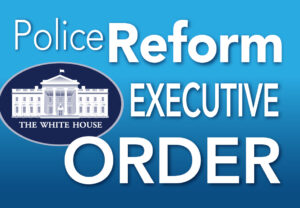New Executive Order Promotes Accountability
Posted
May 27, 2022
Share:
On May 25, 2022, President Joe Biden issued an executive order to address many of the issues that have been a part of the national police reform discourse over the past two years. The order, formally titled Executive Order on Advancing Effective, Accountable Policing, and Criminal Justice Practices to Enhance Public Trust and Public Safety, takes action on reform measures at the federal level, where attempts at more sweeping legislation have been paused since late last year.
 While the text of the order is lengthy, the subject matter and policy priorities reflected in it should not surprise those following the progress of police reform legislation across the country. Much like state-level reform efforts, the order seeks to build public trust through transparency and accountability while acknowledging that law enforcement officers are “frequently call[ed] upon… to respond to social problems outside their expertise and beyond their intended role, diverting attention from their critical public safety mission and increasing the risks of an already dangerous job”.
While the text of the order is lengthy, the subject matter and policy priorities reflected in it should not surprise those following the progress of police reform legislation across the country. Much like state-level reform efforts, the order seeks to build public trust through transparency and accountability while acknowledging that law enforcement officers are “frequently call[ed] upon… to respond to social problems outside their expertise and beyond their intended role, diverting attention from their critical public safety mission and increasing the risks of an already dangerous job”.
At Benchmark Analytics, we carefully track executive orders and law enforcement legislation at all levels of government. What follows is a breakdown of what is in the executive order, what’s not, and, most importantly, what the executive order on police reform means for law enforcement leaders and officers.
Federal Policy Changes
Executive orders are a powerful tool for a president, allowing them to bypass the legislative process to enact policy quickly. However, they are also, by definition, limited in scope. The more immediate policy changes required by the executive order primarily affect federal law enforcement agencies. These policy changes impact the following areas:
- Use of Force: By November of 2022, the heads of federal law enforcement agencies will be required to submit use of force data to the FBI National Use-of-Force Data Collection database on a monthly basis. Furthermore, federal law enforcement agencies under the Department of Justice (DOJ) are required to align policies and training to a 2021 DOJ policy that generally prohibits the use of neck restraint.
- Internal Affairs: The heads of federal law enforcement agencies are required to develop and implement evidence-based training programs for officers concerning implicit bias and profiling. The executive goes a step further in mandating the agency leaders establish procedures for “receiving, investigating, and responding meaningfully to complaints alleging improper profiling or bias by Federal law enforcement officers”. The order establishes both a standard by which officers are trained and, crucially, an accountability mechanism in creating a formalized internal affairs process for investigating and resolving misconduct allegations.
- Training: The Director of the Office of Personnel Management and the Attorney General is tasked with developing an anti-bias training module for federal law enforcement agencies, covering “implicit bias and avoiding improper profiling based on the actual or perceived race, ethnicity, national origin, limited English proficiency, religion, sex (including sexual orientation and gender identity), or disability of individuals.”
- Federal Database: The Attorney General will establish a National Law Enforcement Accountability Database in early 2023. Disciplinary data, citizen complaints, and decertification data will be included. Federal agencies will be required to report to this database, while state, local, tribal, and territorial agencies will be strongly encouraged to report relevant data.
Local Impacts
Though the immediate policy implications of this executive are, by nature, primarily at the federal level, the order does make efforts to apply these changes to law enforcement as a whole. Limited by the power of executive action, the order seeks to affect these changes through best practice and policy recommendations and use grant funding to encourage state and local departments to adopt the changes outlined in the document. A few key elements of the policy recommendations include:
- Developing guidance and best practices to strengthen officer recruitment and retention.
- Identifying needed resources to enact the officer wellness work contained in the Law Enforcement Mental Health and Wellness Act of 2017.
- Supporting state and local agencies seeking accreditation.
- Clarifying regulations on agencies seeking military surplus distribution programs.
- Generally supporting, though grant funding incentives, the adoption of the federal law enforcement standards
A Blueprint for the Future
In the absence of federal reform legislation, this executive order has generally been received as a step in the right direction in addressing issues of transparency and accountability in policing. A press release from the International Association of Chiefs of Police (IACP) and the Fraternal Order of Police (FOP) characterizes the order as “a good faith effort by all involved to reach accord without compromising any core values or issues” while also stating “A broader approach to overall systemic issues needs to be a priority of all elected officials.”
With its input from professional organizations representing officers as well as police chiefs, there’s reason to believe that the action items contained in this executive order have the potential to make an impact on both law enforcement and the communities that depend on effective and transparent policing.
Related Posts
Ready to Experience the Benchmark Difference?
Benchmark Analytics and its powerful suite of solutions can help you turn your agency’s challenges into opportunities. Get in touch with our expert team today.



